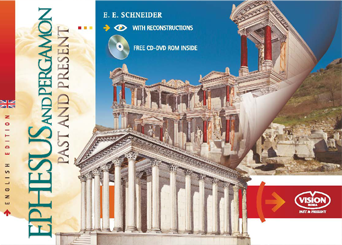Set against the slopes of the Panayır Dağ, the Grand Theatre of Ephesus, one of the largest of the ancient world, was completed during Roman Imperial Age, and could seat 25,000 spectators.
An earlier structure, which must have been much more modest in size, probably dates from the Hellenistic Age, perhaps connected with the new urban plan ordered by Lysimachus of Thrace during the first half of the 3rd century B.C.; the construction of the orchestra pit with its drainage channel, a two-level stage, and the first sector of seats in the cavea most likely date from a second phase in the 1st century B.C.
During the 1st century A.D., and in particular with the emperors of the Flavian dynasty, the building was enriched and enlarged: a new stage was installed, with a façade richly decorated with aedicules and columns arranged in two rows.
The orchestra pit was enlarged and the cavea, built of marble, was equipped with a second row of seats, resting on the external sides against vaulted substructions. Later on a third level was added to the scaenae frons, as was a third row of seats in the cavea.

© Photo credits by Neil and Kathy Carey under CC-BY-SA-2.0
Two diazomata (corridors) and 58 scalaria separated the rows of seats. The highest part of the cavea (summa cavea) was completed with a colonnade.
The theatre was partly destroyed by the earthquake that struck the city in 262 A.D. Other earthquakes, which took place between 359 and 366 A.D., totally destroyed the summa cavea.
During the 8th century, the building was incorporated into the city’s defensive fortification system.

Do you want to know more about the history of Ephesus and Pergamon?
Check out our guidebook to Ephesus and Pergamon, with detailed history and Past & Present images of their greatest historical and archaeological sites.

